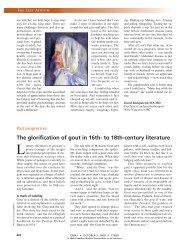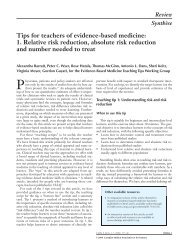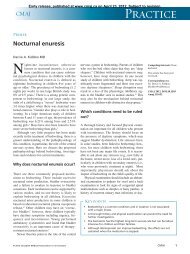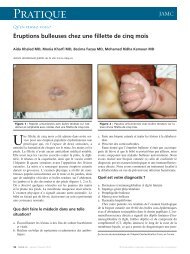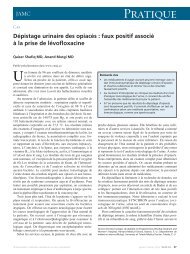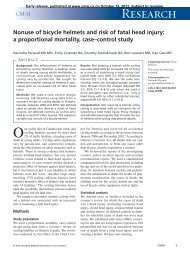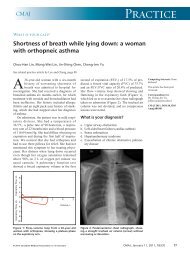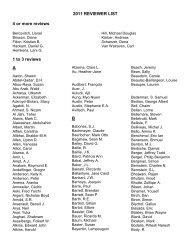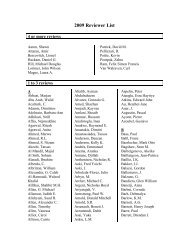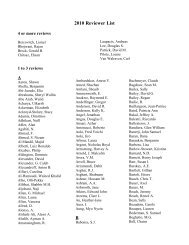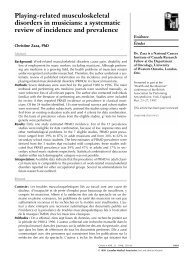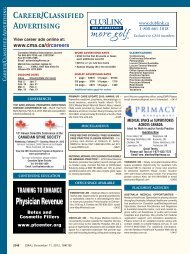Cochlear implants: the head-on collision between medical ...
Cochlear implants: the head-on collision between medical ...
Cochlear implants: the head-on collision between medical ...
You also want an ePaper? Increase the reach of your titles
YUMPU automatically turns print PDFs into web optimized ePapers that Google loves.
Swans<strong>on</strong><br />
cochlear implant, but <strong>on</strong>ly if <str<strong>on</strong>g>the</str<strong>on</strong>g>re is true and legitimate<br />
informed c<strong>on</strong>sent.”<br />
For communicati<strong>on</strong> purposes, he advocates signing in<br />
additi<strong>on</strong> to speech, not <strong>on</strong>e or <str<strong>on</strong>g>the</str<strong>on</strong>g> o<str<strong>on</strong>g>the</str<strong>on</strong>g>r. “There is no<br />
evidence that learning to sign first will get in <str<strong>on</strong>g>the</str<strong>on</strong>g> way of<br />
speech training. In fact, it will enhance it.”<br />
Even if parents decide <strong>on</strong> a cochlear implant,<br />
Bressler suggests that learning American Sign Language<br />
(ASL) before verbal-auditory training will provide<br />
youngsters with language skills, and this can provide<br />
structure and fluidity when <str<strong>on</strong>g>the</str<strong>on</strong>g>y begin developing<br />
oral and written language skills.<br />
To promote informed c<strong>on</strong>sent, Bressler arranges for<br />
parents to meet deaf people. The first meeting will involve<br />
some<strong>on</strong>e with oral but not sign-language skills,<br />
and <str<strong>on</strong>g>the</str<strong>on</strong>g> next with a pers<strong>on</strong> who has <strong>on</strong>ly ASL. “Finally, I<br />
introduce <str<strong>on</strong>g>the</str<strong>on</strong>g>m to some<strong>on</strong>e who has both. They may<br />
not be sold <strong>on</strong> <strong>on</strong>e idea over <str<strong>on</strong>g>the</str<strong>on</strong>g> o<str<strong>on</strong>g>the</str<strong>on</strong>g>r, but this gives an<br />
idea of how people functi<strong>on</strong> as deaf adults. Parents are<br />
extremely appreciative of this eye-opening exposure. All<br />
opti<strong>on</strong>s should be placed <strong>on</strong> <str<strong>on</strong>g>the</str<strong>on</strong>g> table for all to see. No<br />
<strong>on</strong>e side is right and <str<strong>on</strong>g>the</str<strong>on</strong>g> o<str<strong>on</strong>g>the</str<strong>on</strong>g>r wr<strong>on</strong>g.”<br />
Chris Kenopic, president of <str<strong>on</strong>g>the</str<strong>on</strong>g> Ontario Associati<strong>on</strong><br />
of <str<strong>on</strong>g>the</str<strong>on</strong>g> Deaf (OAD), stresses that his organizati<strong>on</strong> agrees<br />
“parents have <str<strong>on</strong>g>the</str<strong>on</strong>g> right to decide what <str<strong>on</strong>g>the</str<strong>on</strong>g>y want for<br />
<str<strong>on</strong>g>the</str<strong>on</strong>g>ir child, as l<strong>on</strong>g as <str<strong>on</strong>g>the</str<strong>on</strong>g>y are provided <str<strong>on</strong>g>the</str<strong>on</strong>g> full informati<strong>on</strong><br />
and understand all <str<strong>on</strong>g>the</str<strong>on</strong>g> opti<strong>on</strong>s.”<br />
However, he thinks that because hearing society<br />
c<strong>on</strong>siders deafness “something that needs to be fixed,”<br />
specialists may not suggest all opti<strong>on</strong>s to parents.<br />
Kenopic emphasizes that OAD is not c<strong>on</strong>cerned about<br />
“losing [<str<strong>on</strong>g>the</str<strong>on</strong>g>] native language [ASL].” He is c<strong>on</strong>cerned<br />
that some physicians have used this argument, “making<br />
[parents] hesitate to meet deaf adults” to explore<br />
alternatives.<br />
The OAD recognizes that funding of cochlear <str<strong>on</strong>g>implants</str<strong>on</strong>g><br />
will c<strong>on</strong>tinue. Kenopic says efforts are now being<br />
made to make resources available to help hearing parents<br />
understand <str<strong>on</strong>g>the</str<strong>on</strong>g> needs of deaf children.<br />
Only now, 16 years after she became deaf, is Kristin<br />
Snodd<strong>on</strong> “breaking into deaf culture.” Ir<strong>on</strong>ically, it was<br />
<str<strong>on</strong>g>the</str<strong>on</strong>g> challenges that came with living with her 22-channel<br />
implant that led to her “awakening” as a deaf pers<strong>on</strong>.<br />
She stopped using <str<strong>on</strong>g>the</str<strong>on</strong>g> implant when she was 19, 4 years<br />
after receiving it. The same year she entered <str<strong>on</strong>g>the</str<strong>on</strong>g> University<br />
of Tor<strong>on</strong>to, where she graduated with an h<strong>on</strong>ours<br />
BA degree this spring.<br />
Although she learned some sign language, Snodd<strong>on</strong><br />
thought deaf people may have rejected her if <str<strong>on</strong>g>the</str<strong>on</strong>g>y knew<br />
about <str<strong>on</strong>g>the</str<strong>on</strong>g> implant. “It’s very difficult to be rejected by<br />
your peer group,” she says.<br />
Meeting o<str<strong>on</strong>g>the</str<strong>on</strong>g>r deaf people and discovering deaf culture<br />
proved a “totally revoluti<strong>on</strong>ary thing” with “a<br />
tremendous impact <strong>on</strong> every single area of [my] life,” she<br />
says. “I accept my differences now that I am aware of <str<strong>on</strong>g>the</str<strong>on</strong>g><br />
deaf culture. My self-esteem has really increased.”<br />
Snodd<strong>on</strong> required fur<str<strong>on</strong>g>the</str<strong>on</strong>g>r surgery last year to remove<br />
her implant because of a “life-threatening” complicati<strong>on</strong>.<br />
If her family had been helped to understand her as<br />
a deaf pers<strong>on</strong>, says Snodd<strong>on</strong>, many pers<strong>on</strong>al, emoti<strong>on</strong>al,<br />
<strong>medical</strong> and o<str<strong>on</strong>g>the</str<strong>on</strong>g>r problems may have been avoided.<br />
Despite <str<strong>on</strong>g>the</str<strong>on</strong>g> intensity of <str<strong>on</strong>g>the</str<strong>on</strong>g> c<strong>on</strong>troversy, Bressler thinks<br />
“we should have an open mind. I may have deafened ears,<br />
but <strong>on</strong>e must have open eyes to look at both <str<strong>on</strong>g>the</str<strong>on</strong>g> deaf side<br />
and <str<strong>on</strong>g>the</str<strong>on</strong>g> n<strong>on</strong>deaf side.” He hopes every<strong>on</strong>e becoming<br />
involved in <str<strong>on</strong>g>the</str<strong>on</strong>g> debate will enter it with eyes open. ß<br />
932 CAN MED ASSOC J • 1 er OCT. 1997; 157 (7)



